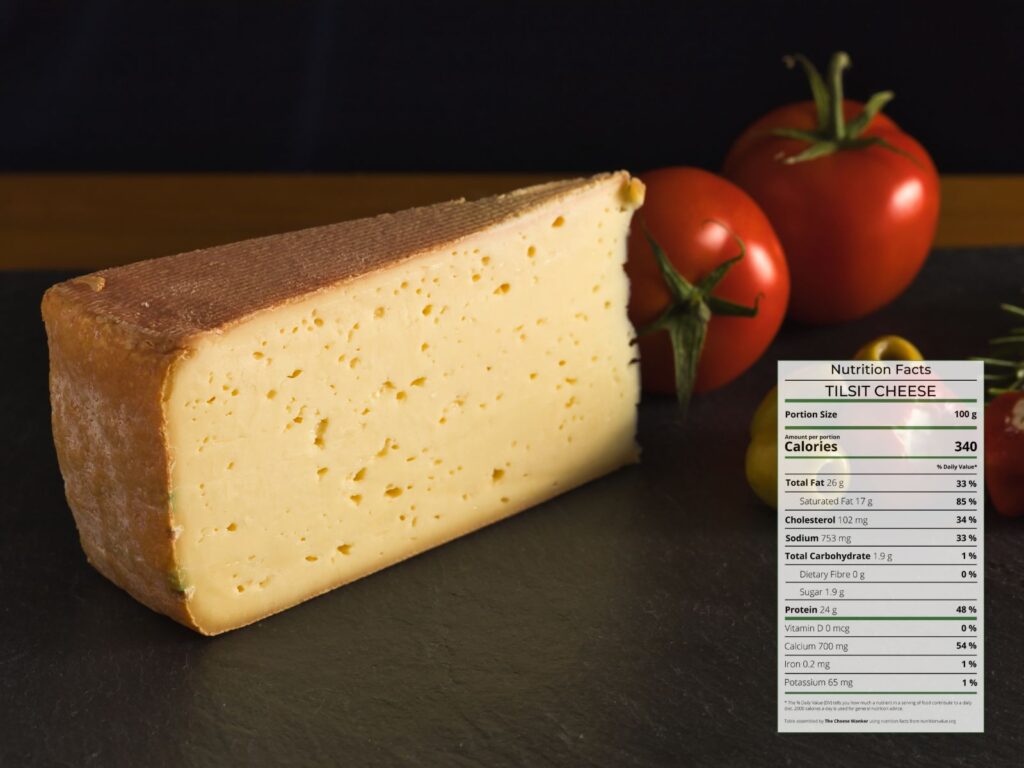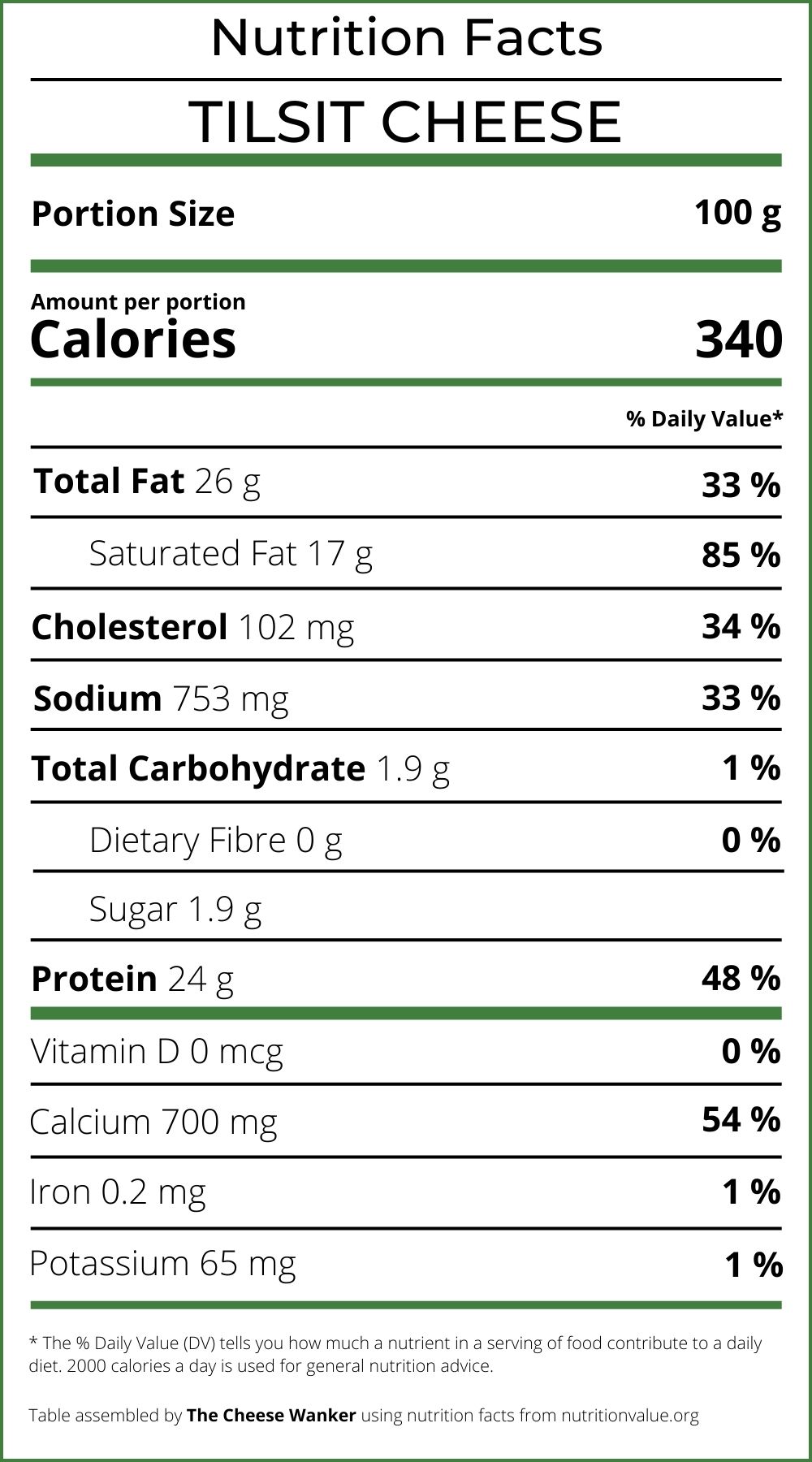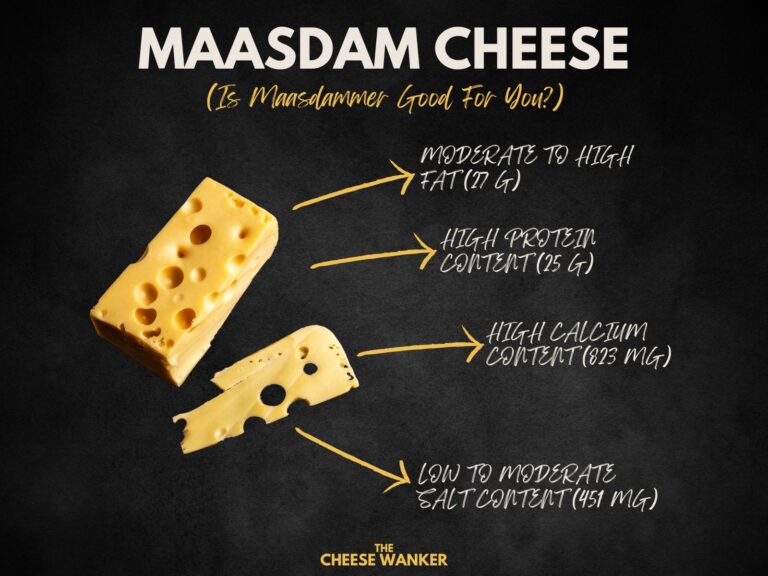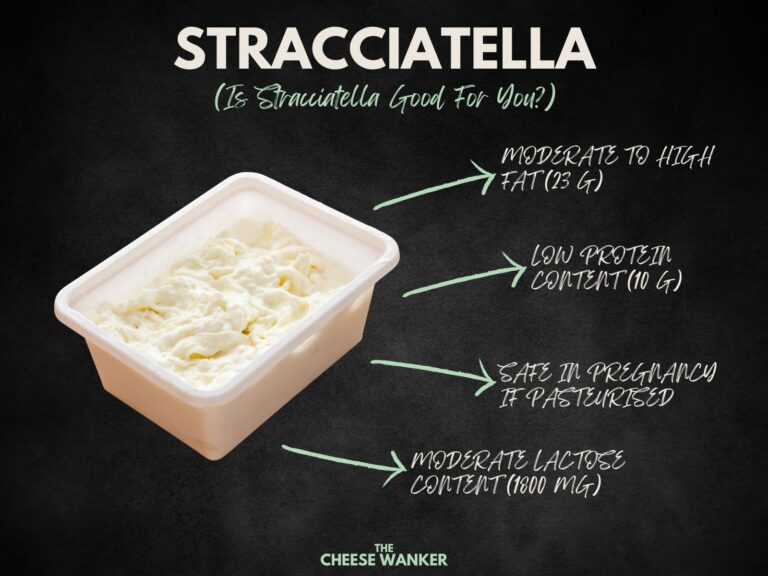Tilsit cheese, also known as Tilsiter cheese, is a semi-hard pressed cheese that originated in the town of Tilsit (now known as Sovetsk) in East Prussia. The cheese is made from cow’s milk and has a pale-yellow colour with small holes. Read on to learn about the nutrition facts for Tilsit Cheese.

SEE ALSO: Nutrition facts for popular world cheeses in The Cheese Wanker’s index →

Nutrition Facts Summary for Tilsit Cheese
Without a doubt, Tilsit is a very popular Swiss German cheese. Here are some of its key nutrition facts:
Lactose Intolerance
Tilsit cheese is a good option for individuals who are lactose intolerant as it has a relatively low lactose content. A 30 g serving of Tilsit cheese contains only 0.1 g of lactose, making it a suitable choice for individuals with lactose intolerance.
Find out everything you’ve ever wanted to know about lactose free cheeses by clicking here.
Fat Content
Tilsit cheese is a high-fat cheese, with a 100 g serving containing approximately 26 g of fat. However, the majority of the fat in Tilsit cheese is unsaturated, which can be beneficial for heart health. It is important to consume Tilsit cheese in moderation to avoid exceeding the recommended daily intake of fat.
Moreover, it is a good option for people following a ketogenic diet. You can learn more about the keto diet and which cheeses are most keto-friendly by clicking here.
Protein Content
Tilsit cheese is a good source of protein, clocking in at 24 g per 100 g. Protein is essential for the growth and repair of cells and tissues in the body, making Tilsit cheese a nutritious addition to a balanced diet.
Want to find out which cheeses have the highest protein content? Click here for our blog post covering this topic.
Safety in Pregnancy
Tilsit cheese is safe to consume during pregnancy, provided that it is made from pasteurized milk. Due to its relatively low moisture content, Tilsit has a very low risk of carrying pathogens such as Listeria. To be on the safe side, you might want to avoid eating the natural rind though.
You can read more about which cheeses are safe to eat when you’re pregnant by clicking here. As always, if unsure, you should consult your doctor.
Salt Content
Tilsit cheese is a moderately salty cheese, containing on average around 750 mg of sodium per 100 g. Excessive sodium intake can lead to high blood pressure and an increased risk of heart disease. It is important to consume Tilsit cheese in moderation and to choose lower sodium options if you are at risk.
Conclusion
Tilsit cheese is a tasty and nutritious cheese option that can be enjoyed in moderation as part of a balanced diet. It is a good choice for individuals who are lactose intolerant and is a good source of protein.
However, due to its high-fat and sodium content, it should be consumed in moderation to avoid exceeding recommended daily intakes. Pregnant women should also ensure that they choose pasteurized Tilsit cheese to reduce the risk of harmful infections.
References
Overall nutritional content
The nutritional content of cheese in our table comes from the USDA Food Data Central Repository, the Australian Food Composition Database and cheese manufacturers. We realise that there can be variations between different brands and producers. Hence, the numbers we have used are averages.
Fat content
Our fat RDI data comes from Cleveland Clinic’s Healthy Fat Intake resource.
Type of fat in cheese as per Harvard T.H. Chan’s The Nutrition Source.
Protein content
Our protein RDI data comes from Harvard Medical School’s Harvard Health Publishing.
Cholesterol content
Is There a Correlation between Dietary and Blood Cholesterol? Evidence from Epidemiological Data and Clinical Interventions? – Maria Luz Fernandez and Ana Gabriela Murillo
Saturated fat, carbohydrate, and cardiovascular disease – Patty W Siri-Tarino, Qi Sun, Frank B Hu and Ronald M Krauss
Effect of cheese consumption on blood lipids: a systematic review and meta-analysis of randomized controlled trials – Janette de Goede, Johanna M Geleijnse, Eric L Ding, Sabita S Soedamah-Muthu
Safety in pregnancy
All the advice relating to what cheeses you can eat during pregnancy in this article is based on the recommendations by health authorities in Australia, the UK and the USA. If you are unsure about what you can or cannot eat, please consult your doctor.
Australia – FSANZ, United Kingdom – NHS and United Sates of America – FDA
Lactose content
Lactose residual content in PDO cheeses
Detection of lactose in products with low lactose content
The analysis of lactose in milk and cheese products by HPLC
Food Standards ANZ Food Composition Database
Lactose & Galactose content of cheese



